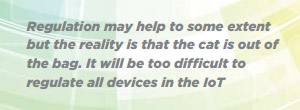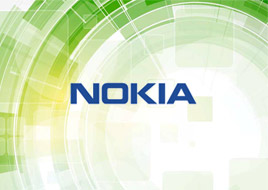Michele Mackenzie, principal analyst at Analysys Mason, talks to Jason Collins, the vice president of Internet of Things marketing at Nokia, to discuss the company’s approach to IoT from technology to ecosystem and business models
Michele Mackenzie: Can you summarise Nokia’s approach to IoT?
Jason Collins: The big news for Nokia last year was the purchase of Alcatel-Lucent. This opened the opportunity for Nokia to have a broad strategy around IoT. We have products and solutions at all layers of the IoT stack, but it’s not just about the technology. There is also growing recognition in the industry of the role of business models and ecosystems. The IoT is about the business models that are facilitated by this new technology. We can have strong products but we need to pay attention to all the other products that are in the market place and integrate those with ours to create new value for the customers. That’s where our ecosystem – the IoT Community, comes into play.
MM: Nokia has a long heritage in connectivity. What are your key focus areas now and how are you approaching optimised networks for the IoT?

JC: Customers are considering many different networks as they move towards an IoT optimised architecture. That demand means we support a wide breadth of technologies but we will always take a standards-based approach. We view LoRa as a standard because the LoRa Alliance is an open, non-profit organisation defining LPWAN protocols around IoT. Standards to us are open definitions of how products can interoperate, encouraging competition and allowing the market to decide which products win and why. I view LoRa and the 3GPP LPWA standards in the same way that I saw Wi-Fi and LTE six or seven years ago. Today nobody is questioning whether I need Wi-Fi or LTE – I need both. Likewise, LoRa and 3GPP standards will co-exist and serve different use cases. NB-IoT will be used where a reliable connection for mission critical applications is required, for example. LoRa will serve other use cases. We are trialling LoRa currently to support an environmental solution and our Impact platform is used to manage the devices in the trial.
We will also support LTE-M and it will be relatively straightforward for operators to add LTE-M services as our network architecture and radios can be upgraded via simple software updates.
MM: What platforms and technologies does Nokia offer to support operators in the IoT? For example, application development, security and connectivity management?
JC: Nokia provides a broad portfolio of technologies across the stack. In addition to supplying the devices and sensors and the connectivity solutions, our IoT platform, Impact, provides the building blocks to manage the device to the connectivity all the way through to building and managing the application.
Nokia has a strong heritage in device management with over a billion devices connected to its solution. In IoT there are potentially thousands of devices connected to a given solution. If there is a security breach for example, you don’t want to shut down the whole network which would incur huge costs. You need to be able to isolate infected devices. Device management will be one of the critical lynchpins of the IoT. We also provide data mediation and security solutions.
MM: IoT security has suffered some setbacks recently with several high-profile distributed denial of service (DDoS) attacks dominating headlines. How is Nokia addressing this issue?

JC: Security is a huge discussion. There is a dawning realisation that the IoT requires an end-to-end security proposition. There has been some work in the industry around how to secure the devices but we believe that only securing the device is a losing proposition. There will always be devices that can’t be secured because they don’t have sufficient computing power or memory. Nokia’s approach has been to focus on the network to ensure that those devices cannot affect the whole solution. The recent security attacks were caused by devices installed in homes with default passwords left unchanged. That’s challenging to fix but, with the right security analytics tools in place, a network could recognise the device’s security software, manage it effectively and detect anomalies in that device’s traffic profile. Then the device management platform or network management tools can fix the problem. Our solution creates a key differentiator for our network service provider customers.
MM: There is a lot of focus on data mediation and analytics but this is still a relatively new area. Do you agree?

JC: This piece of the IoT solution is often under-promoted. To put this into context market statistics around IoT are overhyped. What is the size of the IoT relative to something which we can understand – the internet? If you look at the internet of 2013 compared to 2020, it will be seven times the value of 2013. Then look at value of IoT based on the number of devices that are projected in 2020 and it could be potentially 36 times the value of the internet today. It’s huge but, when you consider that the IoT today is still much smaller than the internet, there is an enormous gap between the projections and the reality. What drove the internet forward was the killer app – search – which allowed data interoperability but that is missing in the IoT today.
MM: So, what is the killer app for the IoT?
JC: In contrast, the IoT is not yet the Internet of Things but more a set of M2M use cases and there is a focus on use cases because we are looking for the killer app, the equivalent of search for the internet. Which is why our horizontal platform, ADEP (Application Device Enablement Platform), is important. The industry will focus on use cases to generate near-term value but it’s also an opportunity for companies to think about how they interconnect people with the value of the things. ADEP is a core component of Impact. It is standards-based and facilitates interoperability of data. It provides an opportunity to create the IoT rather than M2M use cases. That’s not to discount the need for use cases. People need to understand what the good use cases are but if you want to become the next Google you need the platform and you need to interconnect data. A lot of the money in IoT will be made from the analytics.
MM: Do you think that regulation has a role to play in securing IoT devices?
JC: Regulation may help to some extent but the reality is that the cat is out of the bag. It will be too difficult to regulate all devices in the IoT. Even if a government does impose regulation on devices it will only be national, not global. The approach to IoT security should be multi-pronged. There should be some regulation but also best practice. For example, device manufacturers may certify their devices. And it will be critical to have standards-based platforms for interconnectivity so that there is a standard way to access the IoT device. But the most interesting approach to watch in the next two to three years is the role of the network in providing security for the IoT.
MM: In which areas are you most active in working with partners and building the ecosystem for IoT?
JC: Last year at Mobile World Congress we announced our IoT Community which is an open ecosystem to explore new business models for the IoT. When you consider the business models for IoT it is rare that only one company is involved. Multiple companies contribute to a single project. We have built an open ecosystem to collaborate on understanding the value chain and business models for the IoT. The IoT Community’s focus is to take off the shelf products and integrate them with other companies’ solutions. There are currently 350 companies in our ecosystem with 60 companies working specifically on IoT business models.
MM: So how does the IoT Community work?
JC: We pick a vertical or set of verticals and we conduct an ideation session with partners involved in that vertical. Each company has a different role in the value chain and we analyse the opportunities and challenges, the social and industrial trends. We consider what sort of value chains can be created to meet the requirements and then we prototype the solution, test the business models with a key customer and then trial them in the market. We publish the results. Experience has taught me that technology is rarely the main challenge. It’s the business conditions that surround the technology that create obstacles. We assess how we can address those challenges and build the market.
MM: How is this different to the many other alliances that are forming around the IoT?
JC: There are lots of great ecosystems out there but most of them are point-to-point partnerships and focus on how partners can use each other’s products. These are good but our approach is multi-lateral. We don’t involve one company; we involve five companies with different roles in the value chain.
MM: Can you provide an example of one of your IoT Community projects?

JC: Yes, we conducted a trial of a project in New Zealand with several partners. The focus of the trial was on infrastructure that cities own. If those are transformed into smart connected infrastructure they can provide an interesting real estate proposition. For example, a bus shelter with a high bandwidth connection. One stakeholder may be interested in it as a site to place small cells, others will see it as advertising space and the transport company will seek to prove its service key performance indicators (KPIs). This is now being deployed by an integrator partner. The ecosystem is open. Anybody who contributes can launch products based on what we have learned.
MM: What does Nokia mainly gain from the ecosystem initiative?
JC: Some of this is market development to create demand and demonstrate to our customers how they can create business value with the IoT. It also helps us understand the broader market and become faster at execution. Of course, we do this to generate new business but sometimes we don’t work on the projects that arise from our Community. It’s not always our product or solution that is accelerated by the process.
MM: Nokia has traditionally targeted its solutions at network operators. How are you targeting enterprise customers with your IoT offering?
JC: Following the acquisition of Alcatel-Lucent, we have good relationships with communications service providers (CSPs) beyond mobile network operators. One way we sell to the enterprise is through the CSPs. They are important channels for our products.
But we also have a direct sales model to enterprise. We have a set of targeted verticals including: government (smart cities), transportation, healthcare and public safety. We picked a set of enterprise verticals that match our product set and a lot of that is IoT and mission critical networks. We are developing good relationships with the automotive industry in device management. An over-the-air (OTA) firmware update in automotive is a promising place for Nokia because we are very good at device management.
In IoT Nokia is enhancing its perspective towards our customers. Instead of just selling boxes into the engineering department Nokia is understanding customers’ business and delivering products to improve their business process. The IoT makes us more collaborative and helps our customers’ business succeed.










